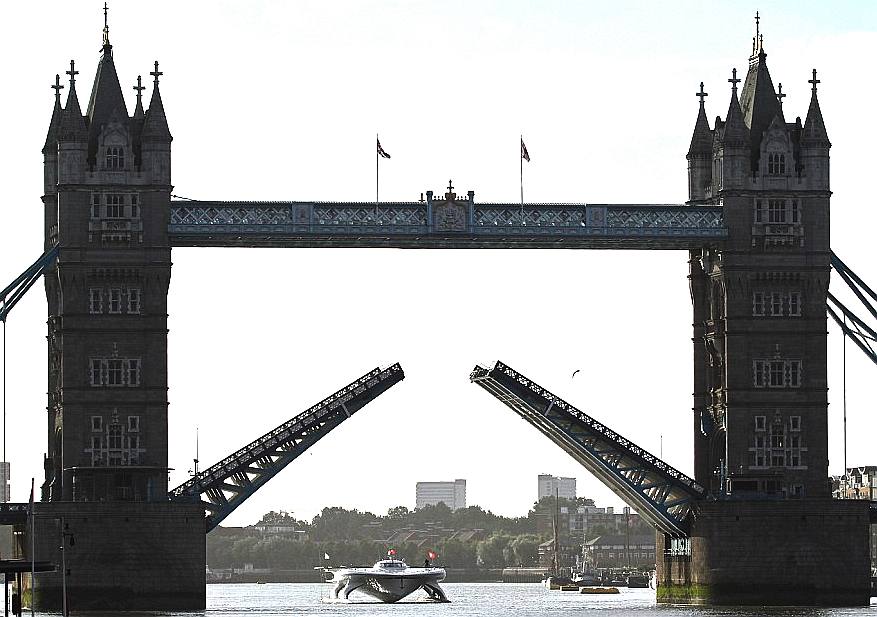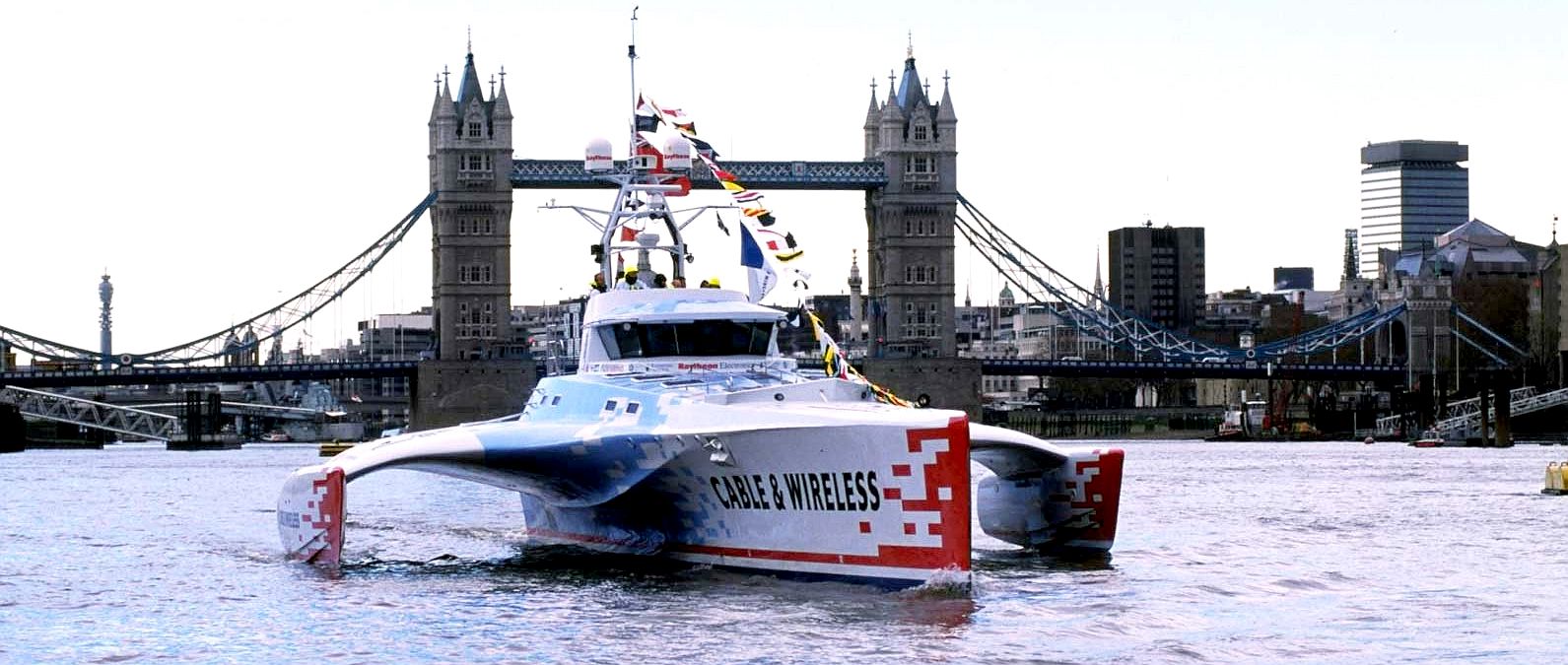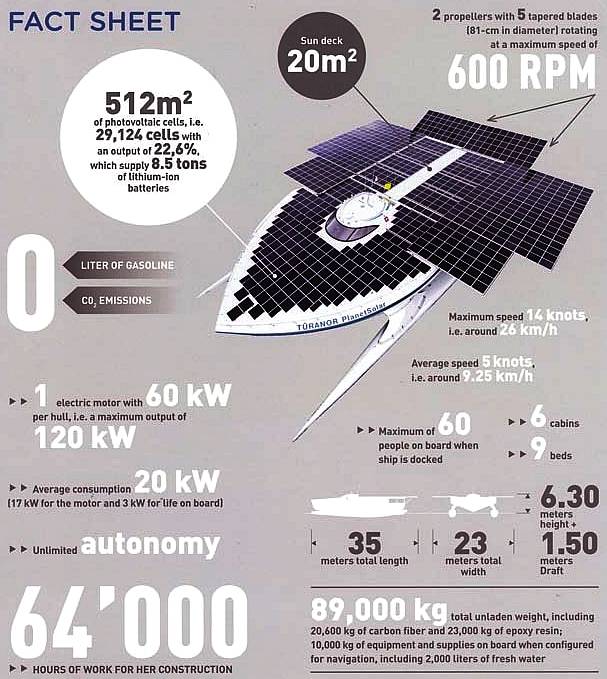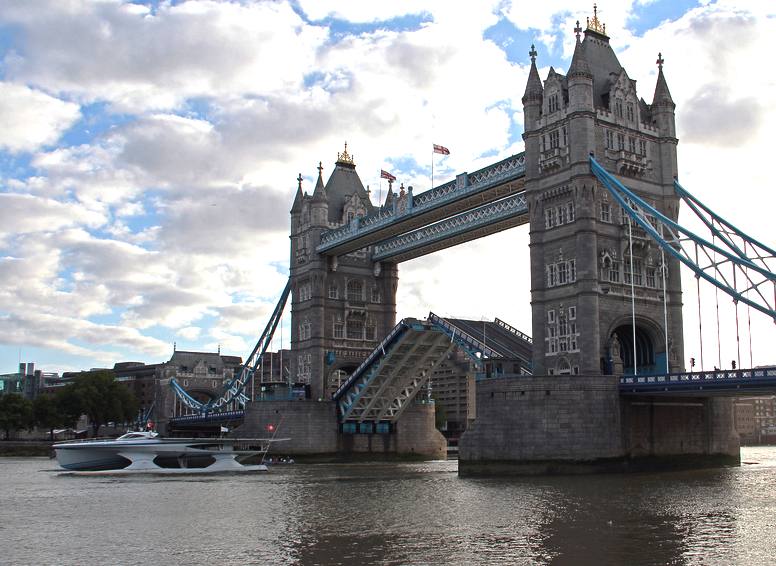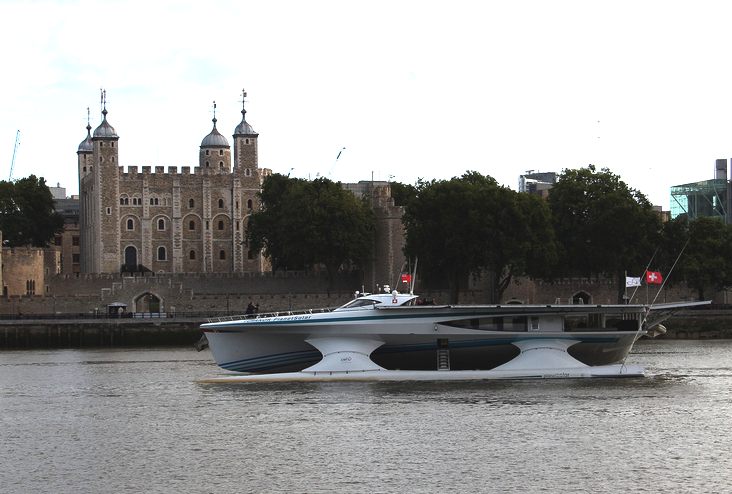|
LONDON - RIVER THAMES
|
|
|
dAfter leaving Oostende (Belgium) on August 30, the largest solar boat in the world reached London a day later, thereby bringing the campaign of scientific measurements along the Gulf Stream (PlanetSolar DeepWater) to a close. The catamaran had been transformed into a scientific platform since the month of June; the onboard team of researchers from the University of Geneva (UNIGE) completed its collection of unprecedented data between Oostende and London. The information gathered will be analyzed at UNIGE. The ship sailed on the Thames for the first time, near the Tower Bridge, and finally moored at the West India Docks in the heart of the British city.
DAILY MAIL
The world’s largest solar boat has docked in London, its final port of call on an epic voyage of scientific discovery along the Gulf stream.
Next stop Paris,
France
The vessel is a scientific research platform for the
University of
Geneva (UNIGE), has a top speed of 14 knots and is home to up to nine crew members at a time, including scientists.
It is stuffed with atmospheric instruments, some of which are prototypes developed by the university.
Led by Professor Martin Beniston, climatologist and director of the Institute of Environmental Sciences at UNIGE, the research team studied the key parameters of climate regulation, focusing on aerosols and phytoplankton. Their aim is to improve the understanding of complex interactions between the ocean and atmosphere, as well as the role these interactions play in climate change.
He said: 'The PlanetSolar DeepWater expedition has allowed intensive testing in real-world conditions of a number of ocean and atmospheric instruments, some of which are prototypes. 'There is now a wealth of physical, chemical, and biological data housed at the University of Geneva, and which is beginning to undergo exhaustive scientific scrutiny. 'Although the data has not been analysed yet, we have noticed some very interesting trends, especially with regards to the production of aerosols by sea sprays,' he said.
Crossing the Atlantic in 22 days, the speedy solar boat compares favourably with a 40 foot sailing ship, which usually takes around 35 days to cross the ocean. The university believes it clearly demonstrates the possibilities of solar power for sea travel, with massive implications for sustainable tourism and transport. We agree, because the Bluefish platform is considerably faster; already considered suitable for several duties that would have the effect of cutting emissions for operators of hydrographic, oceanographic and persistent military monitoring missions.
The boat also plays an educational role as the scientists are keen to raise awareness about environmental issues. One of the aims of the recent expedition, which stopped at Miami, New York, Boston, Halifax and St. John’s before journeying to London, is to promote the use of solar technology.
The Cable & Wireless Adventurer on the River Thames
BLUEFISH DESIGN COMPARISON
The latest British 'Bluefish' contender is somewhat longer at 40 meters (130 ft) and 16.2 meters (52.65 ft) wide in the water, yet is considerably lighter with just 300 meters of solar panels giving more than twice the power to weight ratio of Planetsolar. That will make the patent Bluefish platform the largest solar boat in the world, once it is built. The other key features of this advanced design are the deployment of solar energy harvesting devices (panels, etc) robotically and fully autonomous navigation control options for hydrographic and oceanographic duties. The fact the Planetsolar is being deployed in such manner is proof of concept - except that the Bluefish consortium are aiming to extend that concept into the realms of fully robotic automation - with SWASH hull technology to boost operating speeds considerably such that blue water cruising is expected to be around 7-8 knots with sprints of up to 18 knots, depending on the motors fitted.
You may notice that the reported speed of Planetsolar differs from one media article to another. We had assumed that the PlanetSolar had set a new Atlantic record on the west-east leg of their journey from St Johns, Newfoundland, to St Levan, Porthcurno, UK, some 2200 - 2500 miles covered in 22 days is equal to 4 - 5 knots average speed, but in fact the east-west leg is the record breaking crossing from the Canary Island to St Martins in the Caribbean - some 2500 miles, so once again about 5 knots average - and so much faster than the world circumnavigation speed of about 2.3084 knots (32,410 nautical miles / 585 days / 24 hours). They did lose two weeks, so adjusted that equals 2.36 knots - and they were not racing between media opportunities.
Having studied the design we can say that this is about what one might expect from a catamaran built like this - and 5 knots across the Atlantic is an impressive performance.
CBS NEWS
THE THAMES BARRIER - You can see part of the mechanical workings of the Thames Barrier in this picture. Click on it to see more.
"This boat is a wonderful ambassador for solar energy," D'Aboville said. And then, smiling: "I will not pretend that tomorrow's commercial boats will be driven with solar energy."
LINKS
http://www.cbsnews.com/8301-35040_162-57591895/solar-boat-shines-light-on-suns-power/ Worlds-largest-solar-powered-boat-powers-arrives-Britain-spectacular-style.html?ito=feeds-videoxml http://www.mby.com/news/535154/planetsolar-world-s-largest-solar-powered-boat-visits-london http://www.wharf.co.uk/2013/08/worlds-largest-solar-powered-s.html#more The worlds largest SOLAR boat breaks world record crossing Atlantic just 22 days http://www.nytimes.com/2013/06/25/science/solar-boat-harnessed-for-research.html New York Times solar boat harnessed for research http://solar.calfinder.com/blog/solar-politics/solar-boat-lands-cop16/ economic times india ms-turanor-planetsolar-worlds-largest-solar-boat http://oweolar.info/2012/09/page/33/ http://www.newscientist.com/blogs/shortsharpscience/2011/08/solar-powered-yacht-docks-at-h.html http://au.businessinsider.com/oceanographic campaign to study the gulf stream CBS news solar-boat shines light on suns power http://www.planetsolar.org/follow-us/planetsolar-awards http://www.ship-technology.com/projects/planetsolar/
Jon
Sumida presents a provocative and authoritative revisionist history of the origins, nature and consequences of the "Dreadnought Revolution" of 1906. Based on intensive and extensive archival research, the book strives to explain vital financial and technical matters which enable readers to observe the complex interplay of fiscal, technical, strategic, and personal factors that shaped the course of British naval decision-making during the critical quarter century that preceded the outbreak of the First World War.
Design concept - Raphael Domjan - PROMOTIONAL TOUR 2012
English - Swiss - French - History - Links - Homecoming
The captain of a solar powered ship take on pirate whalers with a $Billion dollars riding on the conclusion.
ACIDIFICATION - ADRIATIC - ARCTIC - ATLANTIC - BALTIC - BAY BENGAL - BERING - CARIBBEAN - CORAL - EAST CHINA ENGLISH CH - GOC - GULF GUINEA - GULF MEXICO - INDIAN - IOC - IRC - MEDITERRANEAN - NORTH SEA - PACIFIC - PERSIAN GULF - SEA JAPAN STH
CHINA - PLASTIC
- PLANKTON - PLASTIC
OCEANS - SEA
LEVEL RISE - UNCLOS
- UNEP
WOC
- WWF AMAZON - BURIGANGA - CITARUM - CONGO - CUYAHOGA - GANGES - IRTYSH - JORDAN - LENA - MANTANZA-RIACHUELO MARILAO
- MEKONG - MISSISSIPPI - NIGER - NILE
- PARANA - PASIG - SARNO - THAMES
- YANGTZE - YAMUNA - YELLOW
|
|
|
This website is Copyright © 2024 Bluebird Marine Systems. The names Bluebird™, Bluefish™, SeaNet™, SeaVax™, Ecostar DC50™, Utopia Tristar™ and the blue bird and fish in flight logos are trademarks. All other trademarks are hereby acknowledged.
|
|
